GIGABYTE BRIX Pro: A Second Look at the Intel i7-4770R with Iris Pro HD 5200
by Ganesh T S on June 14, 2014 5:00 PM ESTPerformance Metrics - II
In this section, we mainly look at benchmark modes in programs used on a day-to-day basis, i.e, application performance and not synthetic workloads.
x264 Benchmark
First off, we have some video encoding benchmarks courtesy of x264 HD Benchmark v5.0.
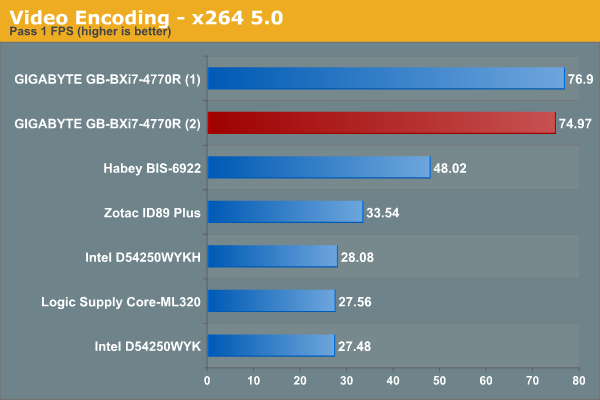

7-Zip
7-Zip is a very effective and efficient compression program, often beating out OpenCL accelerated commercial programs in benchmarks even while using just the CPU power. 7-Zip has a benchmarking program that provides tons of details regarding the underlying CPU's efficiency. In this subsection, we are interested in the compression and decompression MIPS ratings when utilizing all the available threads.
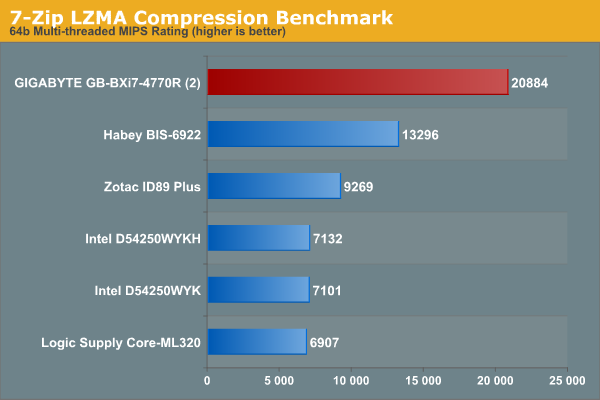
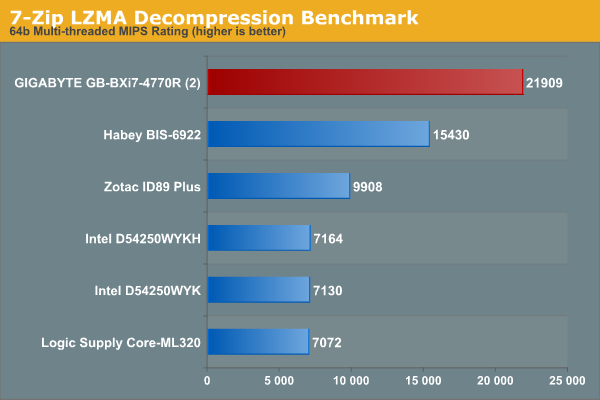
TrueCrypt
As businesses (and even home consumers) become more security conscious, the importance of encryption can't be overstated. CPUs supporting the AES-NI instruction for accelerating the encryption and decryption processes have, till now, been the higher end SKUs. However, with Bay Trail, even the lowly Atom series has gained support for AES-NI. The i7-4770R, being the flagship Crystal Well part for Haswell, hasn't been left behind. It does have AES-NU support and TrueCrypt, a popular open-source disk encryption program which can take advantage of the AES-NI capabilities. The TrueCrypt internal benchmark provides some interesting cryptography-related numbers to ponder. In the graph below, we can get an idea of how fast a TrueCrypt volume would behave in the BRIX Pro and how it would compare with other select PCs. This is a purely CPU feature / clock speed based test.
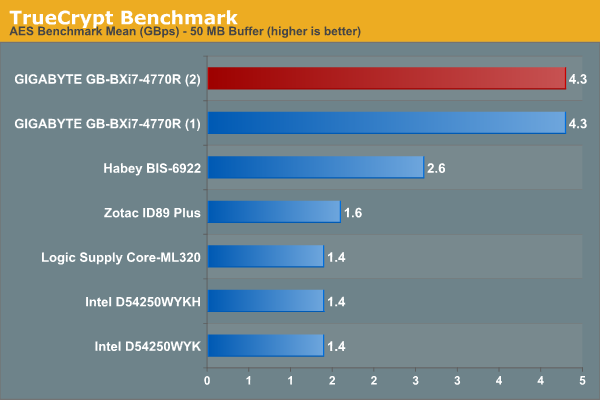
Agisoft Photoscan
Agisoft PhotoScan is a commercial program that converts 2D images into 3D point maps, meshes and textures. The program designers sent us a command line version in order to evaluate the efficiency of various systems that go under our review scanner. The command line version has two benchmark modes, one using the CPU and the other using both the CPU and GPU (via OpenCL). The benchmark takes around 50 photographs and does four stages of computation:
- Stage 1: Align Photographs
- Stage 2: Build Point Cloud (capable of OpenCL acceleration)
- Stage 3: Build Mesh
- Stage 4: Build Textures
We record the time taken for each stage. Since various elements of the software are single threaded, others multithreaded, and some use GPUs, it is interesting to record the effects of CPU generations, speeds, number of cores, DRAM parameters and the GPU using this software.
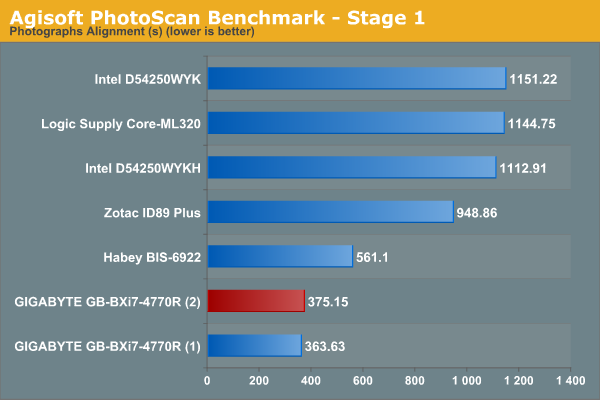
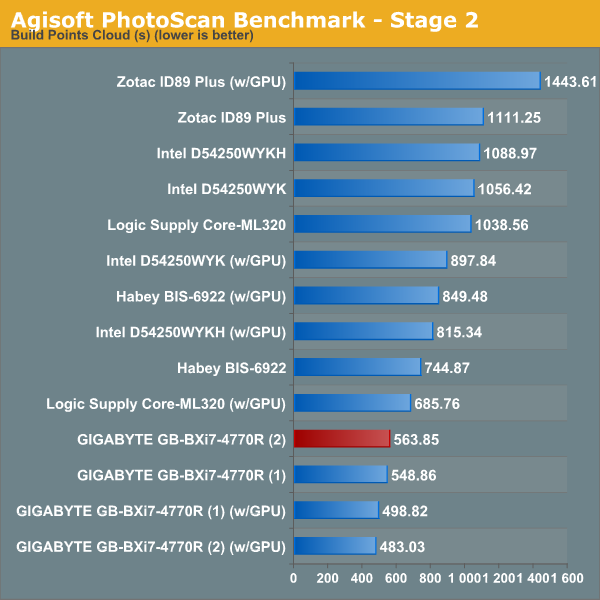
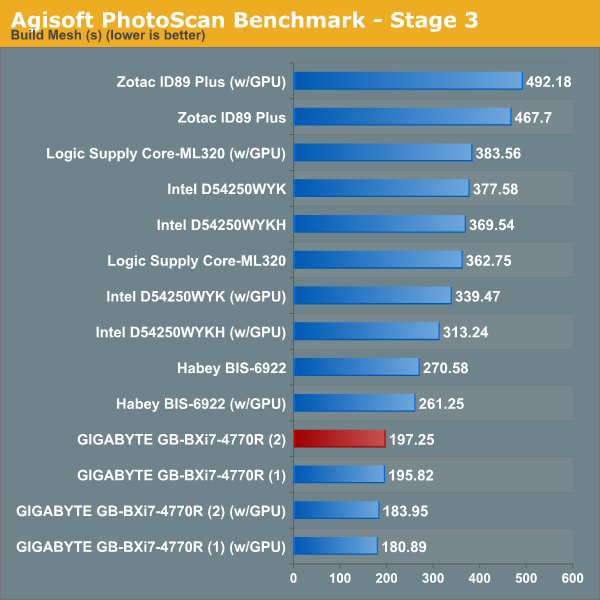
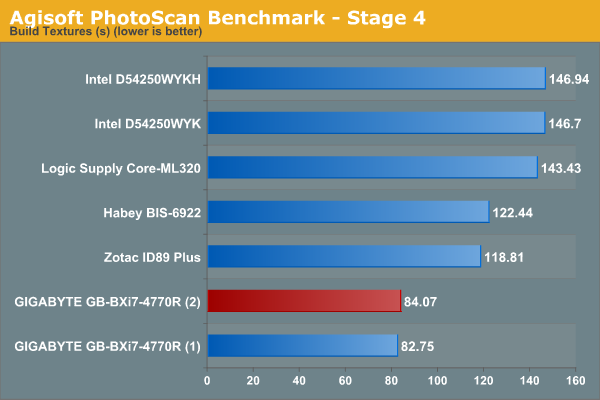
Dolphin Emulator
Wrapping up our application benchmark numbers is the Dolphin Emulator benchmark mode results.
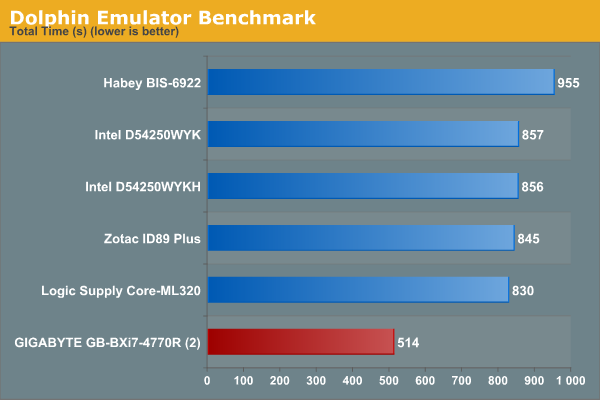










55 Comments
View All Comments
mikk - Saturday, June 14, 2014 - link
No driver version as usual, crap.extide - Saturday, June 14, 2014 - link
A little disappointing, I mean if you are building an iGPU system, you should be going for the best memory you can. 1866 is hardly much of an upgrade over 1600, you can easily get 2133 for a decent price, and 2400 or more if you want to spend.extide - Saturday, June 14, 2014 - link
Also would love to see some AMD APU benchmarks on here as well,And you left in: "(Add note about GT540M if possible)."
Otherwise pretty good!
ganeshts - Saturday, June 14, 2014 - link
Thanks, I fixed that :) I wasn't sure about getting the benchmark numbers from the Vision 3D 252B since I hadn't even booted that up in a long time. Actually, the whole piece was written up even before I started benchmarking that PC (which is why the references to the 540M probably stand out like a sore thumb!)monstercameron - Saturday, June 14, 2014 - link
Intel apus dont respond quite the same as amd ones...ddr3-1600 is as good as it gets.hojnikb - Sunday, June 15, 2014 - link
Yep, crystalwell can really helpddriver - Saturday, June 14, 2014 - link
Disappointing? The best CPU performance you can get in that factor, in which BTW graphics performance is pretty much irrelevant.NeatOman - Sunday, June 15, 2014 - link
1866/cas10 im sure was chosen to show what "normal ram" would result in. Also, if it where 2133/cas12 you would only be trading Mhz for Lantancy NOT resulting in any better performance at all. In fact you may even regress in compute heavy situations.Cellar Door - Monday, June 16, 2014 - link
Absolutely!! I'm also very disappointed in the ram choice of the reviewer - this is 2014 for crying out loud, if you are going to test a $900 system, what's another $30 for a 2400mhz kit - which is what this system should be running. Absolute waste of time... I'm a big fan of this site but its things like this that make me question their integrity. And where is an AMD APU for comparison?!?Wixman666 - Monday, June 16, 2014 - link
Have you guys all forgotten the absolutely miniscule performance differences, in the big picture, between RAM speeds? The higher speed memory just has higher and higher latency, ultimately producing nearly no net gains, and sometimes resulting in WORSE performance. There is a huge article here somewhere that supports that in the memory section. LATENCY has a massive impact on the performance!